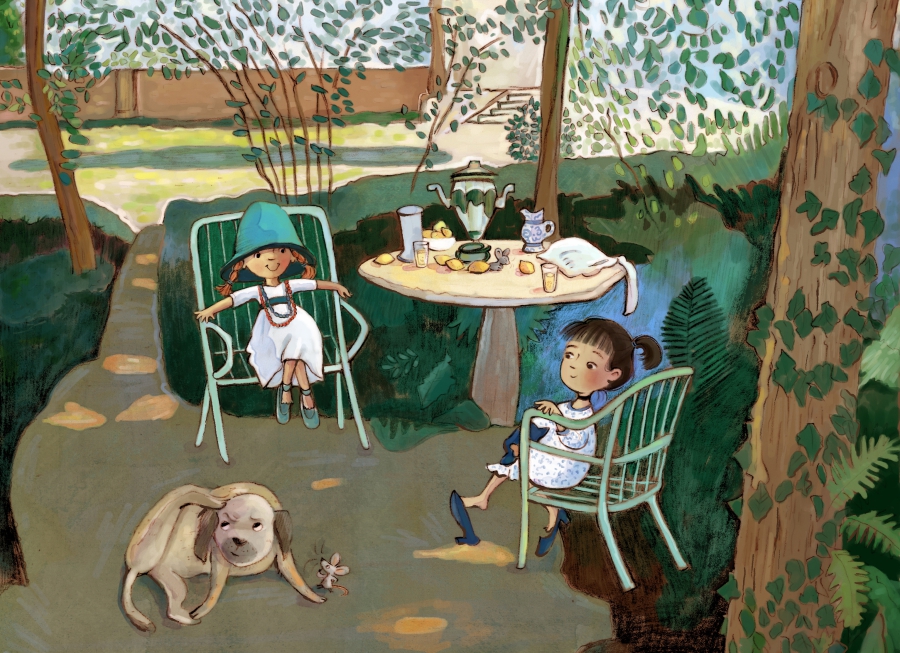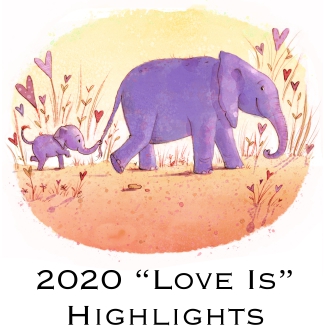
A Big Thank You!
And well, I did it: 52 MousterWorks in one year! (It’s actually 54, since I added in two bonus paintings in June.) Whew! Many thanks to all of you who have joined me to cheer me on; I truly appreciate it. You currently can’t see all MousterWorks because of exciting developments — so stay tuned!

My Changes:
Made the women young children, played around with storytelling, and added a few extra shadows (I couldn’t help myself!).
Things I thought/Questions I asked:
Afternoon tea in the garden is probably not what most of you are thinking about right now, but I hadn’t considered winter or winter holidays when I planned these out. But I’m always up for a beautiful day in the garden, and this garden looks especially lovely. I would love to relax here with a friend. I hear the leaves rustling, the patches of sun filtering through the treetops, and enjoy the dog’s antics. What do you think these girls are talking about? Do you think they’ve been long-time friends? Or maybe they are relatives? Whose house is this? Do they meet often? And what about that dog?
What I noticed or learned from Matisse’s techniques:
Matisse’s work is filled with bold color and shapes. I love the way he paints the groups of leaves, his attention to details (especially the pitchers and the dress pattern), and his bold values. Initially I drew leaves in my sketch, but wasn’t sure if there were enough (and I had grown weary of leaf-drawing). To make sure the treetops didn’t feel bare, I added dabs of digital paint in roughly the shape of a leaf and then added pencil lines underneath to fill them out. (I see I could have added even more on the right side!)
Matisse was 11 years older than Picasso, and their work was often mistaken for the other. Both were highly influential in the direction the art world went in its deviation from a more realistic rendering to flatter colors—and I’m curious to know why people tend to favor that look over something with more dimension!

My Changes:
I made the people younger and defined some elements more clearly.
Things I thought/Questions I asked:
What an amazing gateway on a beautiful day! This masterpiece makes me want to visit Tangier. And I’m intrigued by the people in this picture. The one seated looks like a beggar? And I’m not sure about the one who is standing, but the bare feet made me think he/she might also be someone who is poor. And whose horse is standing in the corner? Also, who built all these buildings?!
What I noticed or learned from Tanner’s techniques:
I am enamored by so many things in Tanner’s painting. First off, the location is so unique. Second, I love how the angle he chooses features the lighting so beautifully! Third, his color palette is so unique, and I’m impressed how sound but subtle the value structure is. And fourth, that texture intrigues me and keeps me looking!
For those who haven’t heard of Tanner, he was an African American painter who moved to Paris because racial unkindnesses caused him severe emotional pain for weeks after each incident. While in Paris, he studied art and gained international acclaim. I’m sad America lost out on enjoying what he offered, and even sadder to know he faced unkindness no human should face—but I am glad he found a place to improve and learn, and where his work could shine.

My Changes:
Turned all the fairies into children (it’s a pajama party!), simplified the number of children, made the visiting girl younger and a different ethnicity, and gave her a book. The colors are also a little lighter so you can see everything clearly. The question I have for you is: what story will she read to them? And what happened to her flute? (Look closely!)
Things I thought/Questions I asked:
What prompted Hughes to come up with this idea? It’s like a special secret we get to participate in. I want to know where this girl came from. Did she know she would run into all the little people? Has she visited before? Where does she come from? My guess is she probably knew the little people would come since she brought along her flute to charm them out of hiding.
And what about all these little people? In the original, you catch small glimpses of each fairy, but I wanted you to see them a little better. It was fun giving them personalities (and pajamas) and considering their story lines. What do they do during the day? In the original, the trail of lights on the right alludes to an entrance in the large tree to the right. In my version, I made the entrance visible (can you find it?). Hopefully they don’t feel too cooped up in there!
I have seen and enjoyed this painting for many years, but (embarrassingly . . .) I hadn’t looked close enough to notice all the fairies until recreating it!
What I noticed or learned from Hughes’s techniques:
My favorite aspect of this painting is the cozy, magical atmosphere Hughes captured. He reminded me that to make something glow, the inner part must be lighter than everything around it, and the glow casts a small bit of light on whatever is close. And although it led for a busy week, I love Hughes’s attention to anatomy and detail. He belonged to the Pre-Raphaelite Brotherhood, who pushed for a return to paintings full of detail and complexity.

When I was little, Mom and I often looked through a beautiful book of Masterpieces. I asked lots of questions about these people painted in time: How were we the same? How were we different? If you are also a fan of masterpieces, children’s book art, and searching for mice, I invite you to follow along!
All original images © Angela C. Hawkins


Love a MousterWork print? They will be available in my Etsy shop. Don’t see the one you want? Email me and I’ll add it in.